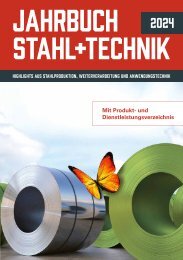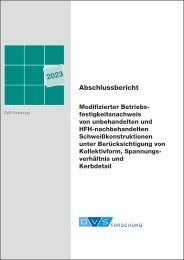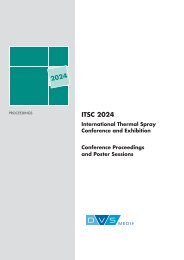STEEL + TECHNOLOGY 01/2020 EXTRACT
STEEL + TECHNOLOGY 01/2020 EXTRACT
STEEL + TECHNOLOGY 01/2020 EXTRACT
You also want an ePaper? Increase the reach of your titles
YUMPU automatically turns print PDFs into web optimized ePapers that Google loves.
60 | <strong>STEEL</strong> PROCESSING<br />
Deep drawing of sheet metal<br />
Monitoring metal sheet infeed during the<br />
pressing process<br />
In cold forming processes, deep drawing is considered a decisive step in the production process. optoNCDT<br />
1420 laser triangulation sensors measure the metal sheet infeed during pressing, as this parameter is crucial for<br />
the quality assessment of the process. Due to their robust design, these sensors are insensitive to shock and<br />
vibration. Based on innovative sensor technology, the measured results are constantly precise even under<br />
challenging conditions such as parts with different reflection characteristics.<br />
optoNCDT1420 1420 sensors measure the metal sheet infeed during deep drawing<br />
(Picture: Micro-Epsilon)<br />
Ablank to be deep drawn is pressed<br />
by the ram into the die (mould).<br />
The flange of the sheet is partially<br />
pulled inwards and distortions can<br />
occure at the edges of the flange as a<br />
result of the deep-drawing process,<br />
when the material “flows“ below the<br />
blank holder from the outer area into<br />
the die. The distortion can be detected<br />
as a change in distance. This value is<br />
crucial for the quality assessment of<br />
the pressed part.<br />
The measurement of the distortion<br />
is carried out using several optoNCDT<br />
1420 laser triangulation sensors, which<br />
are placed around the blank, either<br />
directly installed in the die or blanholder<br />
– or aside the die. Due to their<br />
extremely compact design, these sensors<br />
can be effortlessly integrated into<br />
a small space. The arrangement is chosen<br />
in such a way that the laser beam<br />
is directed on the edge of the sheet,<br />
which is between the blank holder and<br />
the die. Due to the extremely small<br />
measurement spot size, the laser is<br />
able to measure extremely tight gaps<br />
between the two tool parts of less than<br />
one millimetre.<br />
The measured values are transmitted<br />
via analogue or digitally to the controller.<br />
They allow a conclusion to be<br />
drawn on how much material has<br />
flowed. This enables, for example, the<br />
pressing forces to be controlled during<br />
the ongoing process, reducing waste,<br />
material consumption, downtime and<br />
costs.<br />
Even when exposed to harsh ambient<br />
conditions, laser triangulation sensors<br />
from Micro-Epsilon provide reliable<br />
measurement results. They are<br />
rugged and can withstand high mechanical<br />
loads such as vibration and shock.<br />
The Auto Target Compensation (ATC)<br />
feature rapidly compensates for different<br />
reflections caused by high-gloss<br />
through to dirty-matte sheet metal<br />
parts, while enabling a smooth distance<br />
signal.<br />
• Micro-Epsilon<br />
<strong>STEEL</strong> + <strong>TECHNOLOGY</strong> 2 (<strong>2020</strong>) No. 1


















